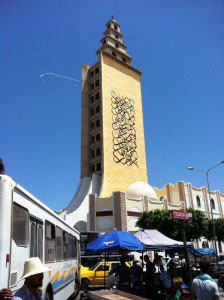Gabès Largest Mosque Covered in ‘Calligraffity’
 The largest mural in Tunisia
The largest mural in Tunisia
Famous for its unique natural landscape that combines oases, sea, mountains, and desert, the coastal city of Gabès, located in the southeast of the country, will now also be known for being the home of Tunisia’s largest graffiti mural on the country’s tallest minaret.
Extending to both sides of the minaret, the mural spells a verse from the Koran, “O mankind! We created you from a single (pair) of a male and a female, and made you into nations and tribes, that ye may know each other (not that ye may despise (each other)” (Yusuf Ali).
“I chose this verse for the humanist message it promotes. It is primarily a message of respect, compassion, and hope, and targets every human being, not strictly Muslims,”“ says El Seed, a calligraffiti artist, and author of the mural.
El Seed is a French-born international artist of Tunisian origin. Merging the two different artistic styles of graffiti and Arabic Calligraphy, El Seed’s work is unique in the sense it expresses a double voice of artistic identity. Originally a graffiti artist, El Seed discovered calligraphy in 2004. His induction of calligraphy into street art serves to address issues of search for identity, origins, and self.
After a former collaboration with Al Khaldounia, a cultural group based in Tunis, on the mural of Kairouan, El Seed was asked to create another project in Tunisia. He chose his hometown, Gabès to be the site of the largest mural in Tunisia as a sign of recognition of his origins.
Built back in 1994, the minaret of the mosque was never painted, leaving the concrete walls of the tower in sharp contrast to the white-washed walls of the rest of the mosque. El Seed felt it would be the perfect place for his new mural, dedicated to his hometown.
While the idea of painting on a mosque can seem controversial, the artist affirmed that his project received welcome and admiration from all different parties involved.
“This project is not just about decorating a mosque, it is about making art a visible actor in the process of cultural and political change,” explained Ed Seed. He added, “I truly believe that art can bring about fruitful debate, especially within the uncertain political climate right now in Tunisia.”
Still unfinished, the minaret seems to have started to garner the attention of locals. Aqila, a resident of Gabès, expressed her happiness about the new minaret, “It is a nice change from concrete walls. The minaret looks beautiful with Arabic calligraphy, and I hope it would be something that distinguishes Gabès from other Tunisian cities,” she said.
“I think it is a marvelous idea,” said Mariem, another Gabès resident.
Since July 20, El Seed has been suspended 57 meters in the air working on the mural, and expects to complete it on August 18. An inaugural ceremony will be held to unveil the mural to the public.
Source: Tunisialive